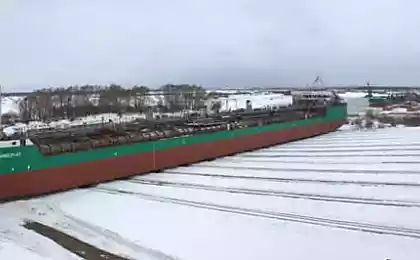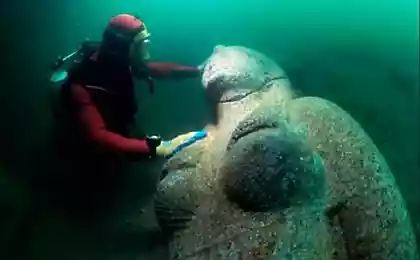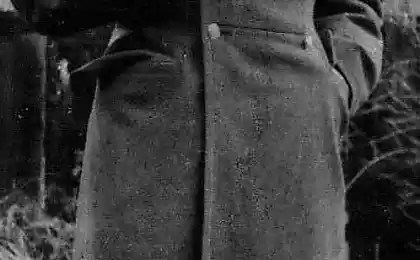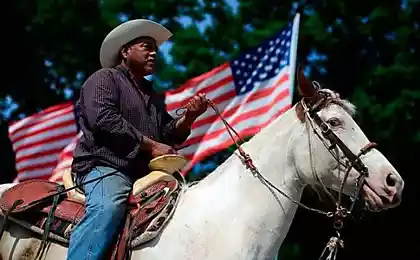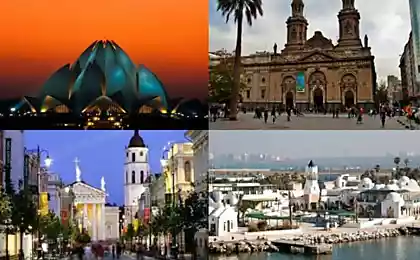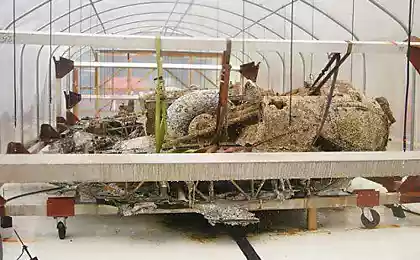789
Heracleon - a city 1,200 years ago, who went under the water
Heracleon - the ancient Egyptian city, which sank off the coast of Egypt 1,200 years ago. The city was one of the most important shopping centers in the Mediterranean area, before he disappeared.
Will be 21 photos.
The ruins of the lost city was found at a depth of 9 meters in the Mediterranean Sea near the city of Alexandria.

1. During the 13 years of excavations c since the discovery of the first artifacts were recovered 64 ancient wrecks and more than 700 anchors. In addition, among the finds were gold coins, weights from Athens and huge slabs with inscriptions in ancient Greek and ancient Egyptian language.
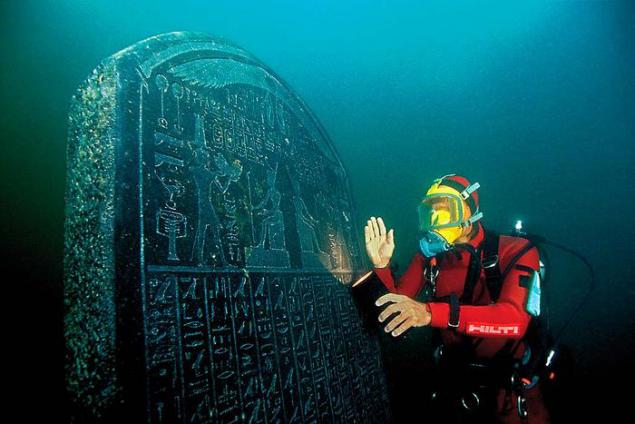
2. The city was flooded by a series of natural disasters around the year 700 of our ery.V Currently researchers have a long work on the archaeological study found sokrovischa.Po According to the director of the Oxford Centre for Underwater Archaeology Damien Robinson (Damien Robinson), who took part in retrieving artifacts , the city was one of the most important sites of antiquity maritime transport, as well as a major cultural center.
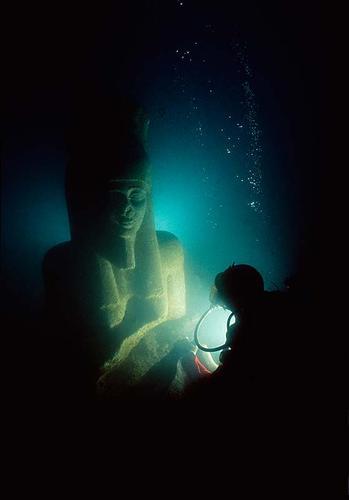
3. Scientists do not exactly know why Heracleon sank more than a millennium ago, but suggest that a gradual rise in sea level, combined with the sudden collapse of unstable sediment has led to the fact that the city fell to a depth of about 3 to 6 meters.
Over time, the city had disappeared from memory, and its existence was known only from a few references in ancient texts.

4. Also found were various religious artifacts sunken city, including a 5-meter stone sculpture, which probably adorned the central church of the town and sarcophagi made of limestone, which were mummified animals.

5. After removing the layer of sand and mud divers found evidence of extreme wealth, which paints a picture of what life was like in Heracleon, who is believed to have been the center of Mediterranean trade more than 1,000 years ago.
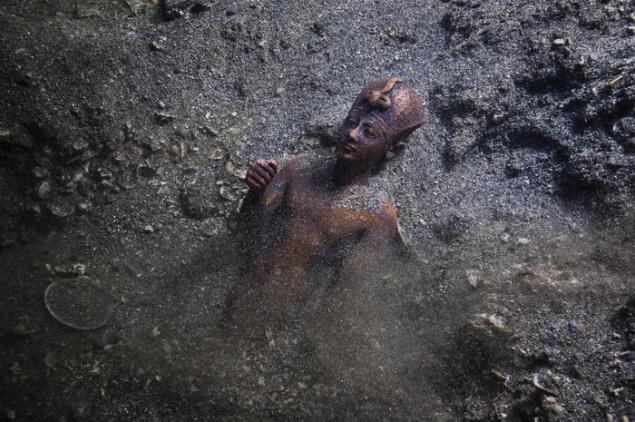
6. The researchers also found the remains of the legendary temple of Amun-Gereb where Cleopatra was given authority to rule Egypt. The temple was the center point of the city. Experts have yet to discover what caused the immersion of the city, but one theory is unstable geological environment, so Heracleon was built on marine sediments, which, combined with rising sea levels may have caused dive all over the city in the water to a depth of about 3, 6 meters.
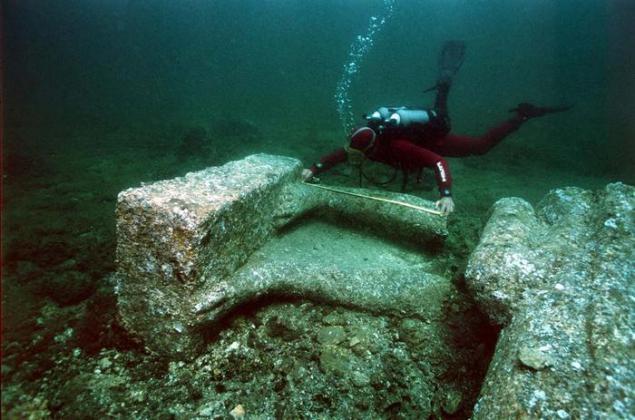
7. only 15-20 days a year in the Bay of clear water. The rest of the year because of the very large amount of silt visibility was no more than twenty centimeters! Anyway mud covers everything and changing the shape of the bottom and objects on it. Not by chance, when he was found "stone", covered with mud and shells, first passed by him, and only then realized - this is the head of the ancient sculpture.
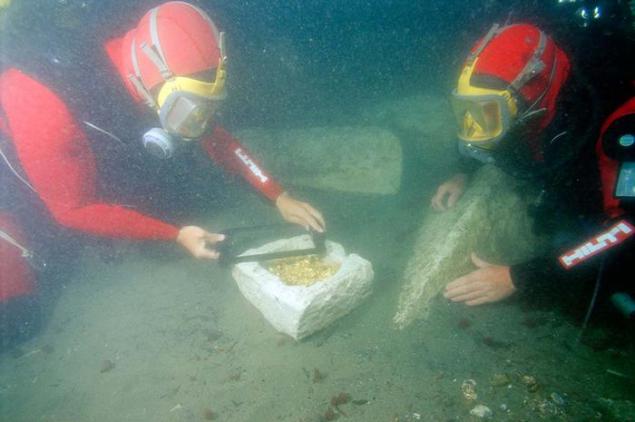
8. The divers worked in extreme conditions. They shoveled "dirt-yl" on an area of about one hundred meters using suction pumps, equipped with filters to any great find not slipped into this "unit" and not broken. If nothing is found, the divers went upstairs to get the next job.
Photo: Bronze oil lamp (2nd century BC) belonging to the temple of Amun.
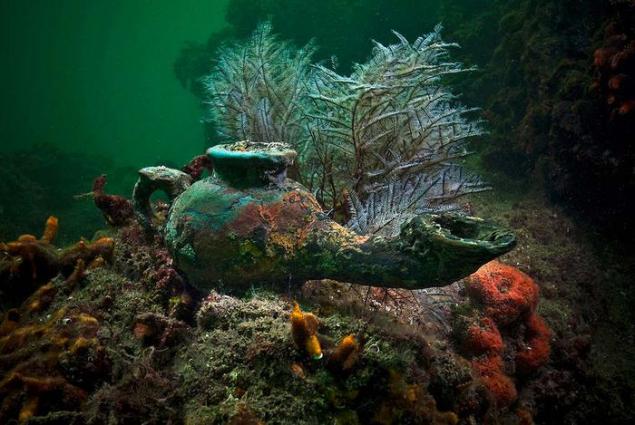
9. In the photo: a fragment of a colossal statue head made of red granite (5.4 meters), symbolizing the god Hapi - god of the Nile and the patron of the harvest in Egyptian mythology. Hapi represented the annual flood of the Nile the great, the rich fertile silt that allowed the Egyptians to grow good crops of grain crops along the banks of this river. His name means "The only current", which means for the Nile. Hapi was also known as "Lord of the fish and birds of the marsh," "Lord of the river bearing plants."
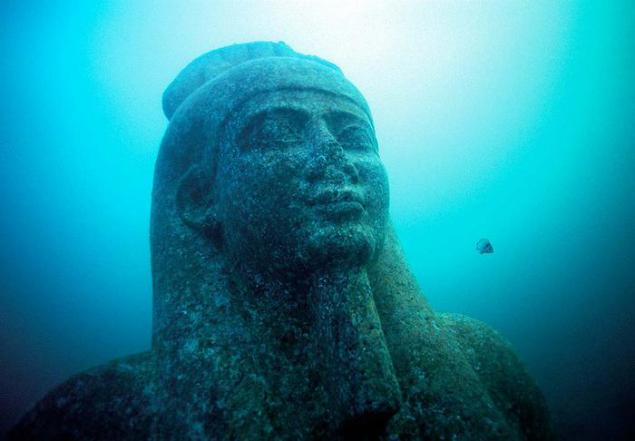
10. Archaeologists raising a statue of the god Hapi, the height of 5.4 meters. She graced the main temple of the city.
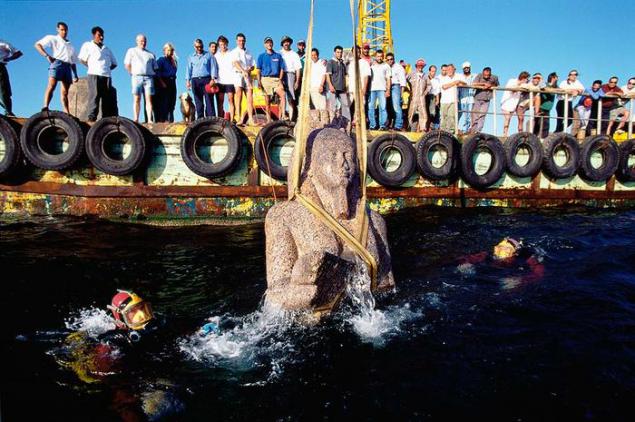
11. In the photo: the archaeologists put together podnyatnye from the bottom of the fragments of colossal stele. Pharaoh, Queen and God Hapi immortalized in red granite. Stela of red granite was collected from 17 wreckage. It dates back to 2. BC
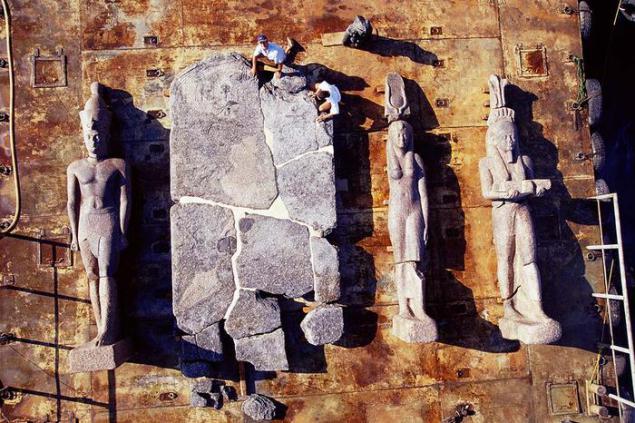
12. This golden object (11 x 5 cm) was found in the course of the preliminary investigation of the southern sector of the city. The plate is engraved with the Greek text of a length of 5 and a half lines. This plate served podverzhdeniem contributions in the name of the ruler Ptolemy III (246-222 BC).
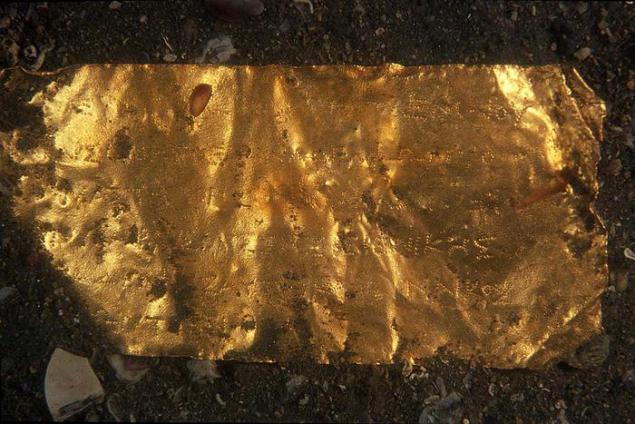
Source:
Will be 21 photos.
The ruins of the lost city was found at a depth of 9 meters in the Mediterranean Sea near the city of Alexandria.

1. During the 13 years of excavations c since the discovery of the first artifacts were recovered 64 ancient wrecks and more than 700 anchors. In addition, among the finds were gold coins, weights from Athens and huge slabs with inscriptions in ancient Greek and ancient Egyptian language.

2. The city was flooded by a series of natural disasters around the year 700 of our ery.V Currently researchers have a long work on the archaeological study found sokrovischa.Po According to the director of the Oxford Centre for Underwater Archaeology Damien Robinson (Damien Robinson), who took part in retrieving artifacts , the city was one of the most important sites of antiquity maritime transport, as well as a major cultural center.

3. Scientists do not exactly know why Heracleon sank more than a millennium ago, but suggest that a gradual rise in sea level, combined with the sudden collapse of unstable sediment has led to the fact that the city fell to a depth of about 3 to 6 meters.
Over time, the city had disappeared from memory, and its existence was known only from a few references in ancient texts.

4. Also found were various religious artifacts sunken city, including a 5-meter stone sculpture, which probably adorned the central church of the town and sarcophagi made of limestone, which were mummified animals.

5. After removing the layer of sand and mud divers found evidence of extreme wealth, which paints a picture of what life was like in Heracleon, who is believed to have been the center of Mediterranean trade more than 1,000 years ago.

6. The researchers also found the remains of the legendary temple of Amun-Gereb where Cleopatra was given authority to rule Egypt. The temple was the center point of the city. Experts have yet to discover what caused the immersion of the city, but one theory is unstable geological environment, so Heracleon was built on marine sediments, which, combined with rising sea levels may have caused dive all over the city in the water to a depth of about 3, 6 meters.

7. only 15-20 days a year in the Bay of clear water. The rest of the year because of the very large amount of silt visibility was no more than twenty centimeters! Anyway mud covers everything and changing the shape of the bottom and objects on it. Not by chance, when he was found "stone", covered with mud and shells, first passed by him, and only then realized - this is the head of the ancient sculpture.

8. The divers worked in extreme conditions. They shoveled "dirt-yl" on an area of about one hundred meters using suction pumps, equipped with filters to any great find not slipped into this "unit" and not broken. If nothing is found, the divers went upstairs to get the next job.
Photo: Bronze oil lamp (2nd century BC) belonging to the temple of Amun.

9. In the photo: a fragment of a colossal statue head made of red granite (5.4 meters), symbolizing the god Hapi - god of the Nile and the patron of the harvest in Egyptian mythology. Hapi represented the annual flood of the Nile the great, the rich fertile silt that allowed the Egyptians to grow good crops of grain crops along the banks of this river. His name means "The only current", which means for the Nile. Hapi was also known as "Lord of the fish and birds of the marsh," "Lord of the river bearing plants."

10. Archaeologists raising a statue of the god Hapi, the height of 5.4 meters. She graced the main temple of the city.

11. In the photo: the archaeologists put together podnyatnye from the bottom of the fragments of colossal stele. Pharaoh, Queen and God Hapi immortalized in red granite. Stela of red granite was collected from 17 wreckage. It dates back to 2. BC

12. This golden object (11 x 5 cm) was found in the course of the preliminary investigation of the southern sector of the city. The plate is engraved with the Greek text of a length of 5 and a half lines. This plate served podverzhdeniem contributions in the name of the ruler Ptolemy III (246-222 BC).

Source:

